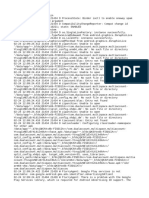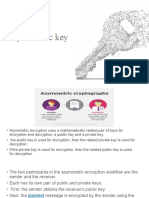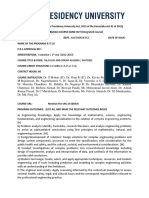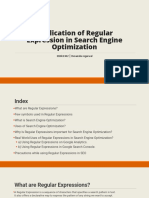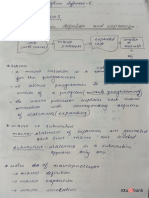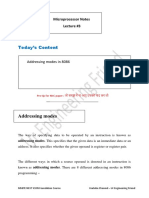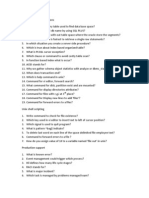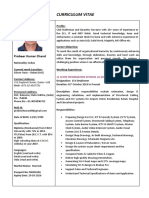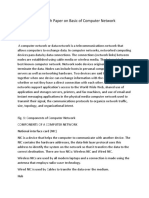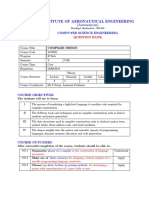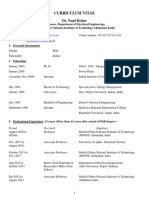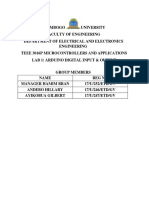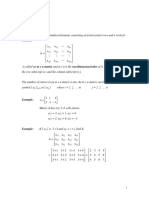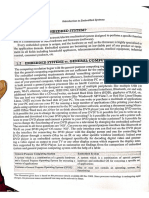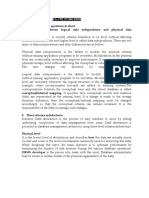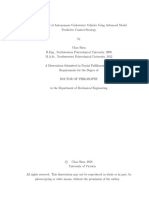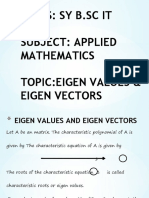0 ratings0% found this document useful (0 votes)
110 views88 pagesMatrices
matrices problems
Uploaded by
suryashiva422Copyright
© © All Rights Reserved
We take content rights seriously. If you suspect this is your content, claim it here.
Available Formats
Download as PDF or read online on Scribd
0 ratings0% found this document useful (0 votes)
110 views88 pagesMatrices
matrices problems
Uploaded by
suryashiva422Copyright
© © All Rights Reserved
We take content rights seriously. If you suspect this is your content, claim it here.
Available Formats
Download as PDF or read online on Scribd
You are on page 1/ 88
a square matrix and |A| #0, then the inverse of A is denoted by A and
adj A
n by A= he
|4|
ACTERISTIC EQUATION
A be the given square matrix. Let 2 be a scalar and I be the unit matrix.
equation |A — Al] = 0 is called the characteristic equation and whose roots
aracteristic roots.
ristic equation of a square matrix A of order three can also be written as
sumof the diagonal |, ,_ | sum of the minors n= |4l =o
elements of A of the diagnoal of A
he
WR -ad’ +a,A-a,=0
2
__ {sum of the diagonal
elements of A
_ |sumof the minors of the
leading diagonal elements of A.
a, =det(A)=|A|
characteristic equation of a square matrix A of order two can also be written as
sum of the diagonal
-| r+ [4] =0
elements of A
V -a,A+a,=0
sum of the diagonal
elements of A
a, =det(A)=|4)
Example 1
ey
Find the characteristic equation of 4=!
3 4
Solution:
Peeler
sien
‘The characteristic equation is |A-Al|=0
(ie.) 2? ~(Sum of the diagonal elements) 2 + [4]
mol
2 -aA+a,=0
(1+ 4)0+(4+6)=0
. The characteristic equation
?-54 +10 =0
Example 2
Slee
Find the characteristic equation of 4=|1 3 1
1o-1e3
Solution:
2 let
Let A=|1 3 -]
1-1 3
The characteristic equation is |A — —Al|=0.
(ie,) 23 -| SUMOF the diagonal 2 4, Sum of the minors
elements of A | |4)
of the diagnoal of A a
Pad? +a,A—a,=0 VOY Wrais ans 2
\e diagonal elements = a, = 34+3+3 =9
= 84848 = 24
Solel: tiga
a, =|Al mildly peg
1 -1 3
=3(9-1)-1 B41) +1 C1-3)=24-4 -4=16
characteristic equation is 43-9? +242 — 16 =0
Exercises 1(a)
the characteristic equation of the following
1] [Ans 12-4 =0]
‘| [Ans: 07-42 +5 =0]
p=
1 ~6 [Ans: 23 +4?—212-45=0]
20
lo 5
3-4
[Ans: 2° -727 +162-12=0]
10 Engineering
1.2. EIGEN VALUES AND EIGEN VECTORS
Let A be a square matrix and I be a unit matrix of the same
scalard, Al will be a scalar matrix, Now A—AI will be a matrix of the sa
A. The equation obtained by expanding the determinant of A-AI and equat
is called the characteristic equation. (i.e.) |A—A I|=0. The roots of this charac
equation are called as the characteristic roots or eigen values of A. The non
%
vector X =| "? | satisfying the equation, (AA) X = 0 is called the eigen vecto
As these equations are homogeneous equations, it can be solved by using method
cross multiplication rule.
Example 1
Find the eigen values and eigen vector ie ‘l
Solution:
4
Let A = 3
5776
The characteristic equation is |A-AI|=0.
0
°
(i.e.) 2? — (Sum of the diagonal elements) 2+ [4]
WV -aA+a,=0
2 — (4+ 6) 2.+ (24-15) =0
?-102 +9 =0
(2-9) (A-1) =0
1=9,1
ie eigen values are 9, 1 ‘ As
vector x-[* Ji given by the equation, (A — 21) X= 0is
-. 31a
5 an [;] cH ae
= 1, the equation (1) becomes
3x, +3x, = : - Q)
5x, +5x,=0
ig arbitrary value to any one of the variables, we obtain the values of XI, X2, X3
1
‘igen vector is X, -| dl
(ii)
4 =9 in (1), the corresponding eigen vector is given by
[? SIE) El
-5x,+3x,=0
Engineering Mathematics
5x, -3x,=0 oo
By giving arbitrary value to any one of the variables, we obtain the values of x, x)
as follows.
()= 5x,-3x,=0
15-3x,=0
The eigen vector x, =5
3
The eigen vector is X, -(;]
1 3
eee
5)
Example 2
8) on
Find the eigen values and eigen vectors of |-6 7 —4 (P.U Nov-200
2 -4 3
Solution:
oC
LetA=|-6 7 -4
aaa
The characteristic equation of A is |A -2 I|=0.
s f the di ‘inors
oe -[nme e diagonal J, , [sum of the minors Fee
elements of A of the diagnoal of A
Sum of the diagonal elements = 8 + 7 + 3 = 18
Sum of the minors of the diagonal=|7 ~4, [8
4 3|'b g
4
8 -6
Cag
‘Matrices 13
=5+20+20
=45
8 6 2
laj=|}6 7 -4
2-4. 3
= 8(5) +6 ( 10) +2 (10)=0
The characteristic equation of the given matrix A is
23-1812 +452 = 0
(02 — 184+ 45) =0
2. =0 or (X?— 182+ 45) =0
WeON(N=15)( = 3)=0
1=0,0=15,3
A=0,15,3
+, Eigen values are 0, 15, 3
x
The eigen vector X =| x, |is given by the equation, (A— Al) X= 0 is
x
8-2 -6 2 ][x
fie)| -6 7-A —-4 ||x, |=0 ()
2 —4 3-A]\|5
Case (i)
When A = 0, equation (1) becomes
8 -6 2][x
-6 7 -4l}x,|=0
Pe esac
fle) 8x, -6x, +2x, =0
la
6x, + 7x, 44,90
2xj-4x, +34, 90
From the first two equations, we have
- Li - x
m6 2) |2 8] [8 -6
7 ll |-4 -6 Ie 7
te
24-14 -124+32 56-36
Seamed Ae
OS Pie a
10° 20 20
I
«The Bigen vector X; =
2
Case i)
When A= 15, equation (1) becomes
-7 -6 2 1[y,
[76 -8 -4//x,/=0
2-4 -12 Xy
(ie) 77, 6%, +2%,=0
rox, ~B8x, -4x,—0
2% = 4%, -125,—9
From the first two equations We have,
i a or AL
Rimeaaicabn. 2, ~ 5 ~ 2
Matrices
2
«The eigen vector X2 = | -2
1
Case (iii)
When 2 =3, equation (1) becomes
Bmeo 2 | (x,
-6 4 -4||x,|-0
2-4 0 ||x,
(ie) 5x, -6x, +2x, =0
6x, +4x, —4x,=0
2x, —4x, +0x,=0
From the first two equations we have,
ho % at
ae op 1
icmeeee ic ° 2
2
«. The eigen vector X3 =| 1
2
Tl alealale
*. The eigen vectors are | 2|,|-2],| 1
2] [1] [2
Example 3
wane
Find the eigen values and eigen vectors of |2 5 0].
ia) a
The characteristic equation is
23-100? +272- 18=0
2=1,3,6
~.Eigen values are 1, 3, and 6
Ba
The eigen vector =| x, lis given by the equation, (A =A) X =O ig
5
2-2 2 0 Tx,
2 5-2 0 ||x,]=0
0 0 3-ajly
Case (i)
When A. = 1, equation (1) becomes
s,wehave (Since first two equationsare identical)
}.=3, equation (1) becomes
“f-1 2 ojfx,
Bee 0||x,|=0
0 0 ollx,
Bae ex, +0x, =0
2x, +2x,+0x, =0
Ox, + 0x, +0x,=0
rom first two equations, we have
18
0
~. The eigen vector X»=| 0
-6,
Case (iii)
When = 6, equation (1) becomes
42 O}fx,
2)051),0,),| x); 20.
00 -3| |x,
ie.) 4x, +2x, +0x,=0
2x, -x,+0x, =0
Ox, +0x, 3x, =0
From the last two equations, we have
Ba eae
+: The eigen vector x, =| 2
0
~. The eigen vectors are
2]fo]fa
-1],} 0 |,Jo
0} {-6| |o
Example 4
3 107985)
-2) 37a
3) Sa
Find the eigen values and eigen vector of
u diagonal 92 4 Sum of the minors Pelt aig
ements of A of the diagnoal of A al
diagonal elements = 3—3+7=7
e minors of the diagonal=| > “14 54/3 10
5) 7B Be eee
=-14+6+11=16
BE 10) 5
la =|2 3 4
Bie'sin 7)
= 3(-21+20) — 10 14 + 12) + 5(-10+ 9)
=-3+20-5=12
e characteristic equation is A? - 72? + 162 - 12=0
The eigen yalues are A = 2, 2,3
x
le eigen vector X =| x, |is given by the equation, (A - AI) X= 0 is
; e
cao 10 Allen
-2 -3-r -4/|x,|=0 ~@
3 5 7-2| Ls
x
1 i
=4||%
-5
of o
ge
=0
x:
(ie) gnidn +5 3 ;
a2) 5x, 45>
3x, +5% + 5X3 =0
i have,
From the first WO equations, We
x Oa 4
ags25 LO
aes
igs -4
-15
5)
The eigen vector Xi=| 2
=5
Case (ii)
When A = 3, the equations (1) become
0 10 5][x,
eae) 4)|| 0.
Ses) 4 |||
(ie) Ox, +10x, +5x, =0
~2%\-6x, 4x, =0
3% +5x, +4, =0
A
Tom first two equations, we have
Pa
ee
~40+30 STO On. 30
(P.U April-2007)
istic equation is |A —A1|=0
_[sumof the diagonal ],, ,[sumofthe minors J, _) 4 _ 9
~_ [elements of A of the diagnoal of A ais
of the diagonal elements=2+3+2 =7
3 1 j2 1,22 2
4 +e
n ah 3
2 QI
=44+3+4=1
of the minors of the diagonal
Pe? 1
j4j=|1 3 1
1 2 2
=2 (6 -2)-2(2-1) + 12-3)=8-2-1=5
stic equation is 4° -7A7 +114-5=0
N= tle
en values are 1, 1,5
a
4
=e rei les
1 2 D-Al|ls,
Case (i)
‘When 2. = 1, equation (1) becomes
1, 2 al fed
1 271|\\be 0)
12 lee
Ge) x+2x, +x%) =0)
xt2x, +x, =0
x, +2x, +x, =0
By giving arbitrary value to any one of the variables, we obtain the values of x1, :
*
as follows.
x +2x, +x, =0 Qe
Let x,=0
(2)> 4+%,=0
Aa
4.= 5, equation (1) becomes
=3 2 1|[x,
ie 2) 10} lc! =)
fie 2) 3)\ |e,
3x, 42x, + x,=0
*%-2x, + x,=0
%,4+2x, -3x,=0
‘Tom the first two equations, we have
24
-1) [-2] |!
“+ The eigen vectors are | 0 |,} 1 },} 1
1 oO;
Example 6
6 =Glag
Find the eigen values and eigen vectors of |14 —13 10)
7 -6) 4
Solution:
O76 ‘SI
LetA =|14 -13 10
Tee GE
The charsicteristic equation is |A ~A1|-0.
: sum of the diagonal sum of the minors
(ie) a= = 22 4 =
nh elements of A> of the diagnoal of A
a
Sum of the diagonal elements = 6—13 +4 =~
I-13
Sum of the minors of the diagonal =| !> 19 ,|6 5
-6 4/ 17 4!
= Se G—3)
Omen 65.
[4j=fl4 -13 1
Be 6s 4
= 6(- 52 + 60) +6 (56-70) + S(-84 +91)
= 6(8)+6(-14)+5(7)=-1
The characteristic equation is 43 +34?+3,4] = 0
~. The eigen values are 4 =—1, ~1, -1
14x, - 12x, +10x,=0
7x,-6x,+5x, =0
the three equations are identical.
By giving arbitrary value to any one of the variables, we obtain the values of x1, x2, xs
LOWS.
x,=0
Q)=> 7x,+5x,=0
TX, =O
26
Case (ii)
Let x,=0
(2)=> 7x,-6x, =0
eae
6"?
6
~. The eigen vector Eg = 17,
0
Case (iii)
Let x,=0
2) >~6x, +5x,=0
6x, = 5x,
poe)
3 6
0
~. The eigen vector X,=/5
6
Example 7
Find the eigen values and eigen Yectors o;
Solution:
ee
LetA =/1 5 1
ami
f
1
1
a
ere
uation is |A—Al|=0,
diagonal 92. +, Sum of the minors
of A of the diagnoal of A
nal elements = 14+5+1 =7
p- |4| =0
Ste sy i yl
s of the di = + +
of the diagonal i | t | I {
=4-8+4=0
ed 3:
eS) oT
Lead:
$1 4)-1 2) +3 C14) =-36
1e characteristic equation is 4° -727 +36 =0
nel)
) 3x+x,+3x,=0
meets x, + x,=0
28 a
3x, tx, $3.70
we have,
From the first two equations
©. The eigen vector Xi=| 0.
Case (ii)
When A =3, the equation (1) becomes
1 3 fx
21 |x, |-0
Beet?) x,
(ie) 2x, +x, +3x%=0
%, 42x, + x,=0
Bara 2, %=0
From the first two equations we have,
~The eigen vector Xp = Bl
1
»
(P.U Nov-2001) Ans.7, 1, 13] =I},
0
Engineering Mathem
0
Ans.1, 3,2; : 1
‘{o}
01]
Wy
1
31
4% a ay
A=) ay Gy Ory
ay, By ay
ay ay ay)
M=\ay ay ay
i iy Genes
cteristic equation of A is |A—) I|=0.
en Ae ie
fo eu! 4% Ay—-A ay |=0 aeaGhy
4s Gy aA
istic equation of A’ is| 47 —A I|=0.
]qy-A ay 4,
4. Ay—-A ay |=0 + Q)
ce Gy — A
nce is |A-A I|=| A” —2 Il, we have equation (1) and (2) are the same. Hence the
istic equation are the same for both A and its transpose 47
If A,,A,,...,A, are eigenvalues of matrix A, then the inverse 4” has the
eigenvalues
es
Ady Ay”
_ Let 2 be an eigenvalue of A
AX= AX ss CO
1S an eigenvector and X #0)
A"(AX)= A'(AX)
33
6:
Tf AjAynd, are eigenvalues of matrix A, then the matrix A- kI has the
eigenvalues 4, -k,A,—k,,..,4,—k,
“We know that
= AX= AX
(@)
KIX on both sides of (1) we get
Ak-KIX = 2X -kIx
(A-kl) X=(A -kI) x 1)
mparing (1) and (2) we have, A- KI is an eigenvalue of the matrix A - ki
Seeing t0 the eigenvalue 2 of A.
re the matrix A - kI has the eigenvalues 4, —k, 4, —k,,...,4, —k. corresponding
fothe eigenvalues 4,4,,....4,.
Property 7:
If 4,4,,....4, are eigenvalues of matrix A, then the matrix 4? has the
eigenvalues
| ae
Proof:
We know that
q AX= 1X + ()
Premultiplying on both sides of (1) by a scalar k,
i A(AX)=A(AX)
4 X=A(AX)
@X=A(AX) (by (1)
| AX=2?X + Q)
ite
‘Matrices 35
property 2:
IfXisa characteristic vector of a matrix A. corresponding to a characteristic root 7,
then KX for every non zero scalar k, is also a characteristic vectorof A corresponding
tod
Note: 1
This theorm implies that: To one characteristic root we have many eigenvectors.
Note: 2
To above theorm may also be stated as follows: Corresponding to a characteristic root
A of A there are different eigenvectors.
Property 3:
An eigenvector X of a matrix A cannot correspond to more than one eigen root
ofaA.
Proof:
Let A be the given matrix and let X and Zbe the eigenvector and eigenvalue
of the given matrix.
We have AX = AX
Suppose the eigenvector X of a matrix A correspond to two different eigenvalues say
Aiand A of the same matrix A.
Then by definition we have
AX=11X%
AX= A2X
From (1) and (2) we have
AiX= AX
(Ai- An X=0
But X +0 (by definition of eigenvector)
Therefore 41- A2=0
Ai=A2
Hence the existence of two different eigenvalues is not possible
eigenvector.
1.4, CAYLEY - HAMILTON THEOREM
Cayley-Hamilton theorem (Statement) E
Every square matrix satisfies its own characteristic equation,
Example 1
10a ie
Verify Cayley—Hamilton theorem for the matrix On ;
1a. ji
Solute These. Q To Ke
The characteristic equation is given by [A — 21 =0, :
ie) 32 | SUMof the diagonal ], , [sum of the minors E
.€.) 03 22 + vonnal nea A= 14] =A
te [ees ofA | [Er diagnoal a alder at
Sum of the diagonal elements = 1-141 =1
Sum of the minors of the diagonal = L j + [!
Anew nai)
Yob4 4
A xiiger
pai Ge 1S ela
a
AS_hmtg Tet et 6 10k
t
Matrices oF
1 0 -4]/0 1 -4] [17 -8 -8
ite] 0: <1 2/0" SI e2rlees 5 1 0)
At ee ean alse lov Pan
49 -8 -92
A=|-8 -5 42
-92 42 53
49 -8.-92] [17 -8 -8] [21 0 -84
A-A- 214 -11=|-8 -5S -42|-|-8 5 O]-| 0 -21 42 |-11
-92 42 53] |-8 0 21] [-84 42 21
veo
=|0 00
000
.. The given matrix satisfies Cayley — Hamilton theorem.
Example 2
Verify Cayley — Hamilton theorem for the matrix A and find 4” where
Bol 1
A=|-1 2 -1].
1-1 2
Solution:
The characteristic equation is given by |A - AI| = 0.
(ie,) 43 _| Sumof the diagonal |, , {sum patie minors a |4| =0
elements of A of the diagnoal of A
Sum of the diagonal elements =2+2+2=6
Sum of the mi i =|? ae ; 44
l¢ minors of the diagonal tlie) linaallMieiel hell 2)
=(4-1)+(4-1)+(4-D
=3ora= 9,
Engineering Mathematic
Engineering Mathematic
2 le
J4/=|-1 2 -1]
= ae:
=2(4-1) + 1(-2+1)+ 11-2)
=2(3)+ 1-1) + 1(-1)=6-1-1
|AF4
<. The characteristic equation is 1° - 62? +91—4 =0
Replacing A by A in the above equation, we get
A3-6A7+9A-4 =0 ose (LY
2-1 1 2 1 el
A?=|-1 2 -1//-1 2 -1
Wee 2) 1 1 2 2
6 -5 5
=|-5 6 -5
S50
6 -5 5][2 -1 1
A=4xAs=|-5 6 -S||-1 2 -1
Bee S 6, | |el | 2
22 -21 21
=|-21 22 -21
pie oie o7
Sub A%, A?, A in (1)
22-21 21 Ges as 2
Lol 1.0 0
=21°22 -21/-6}-5 6 5149/1. 2..-1) =4| 00d: 0|=0
oe eal 22 ee om 0) 1 -1 2 0) Oa
©. The given matrix satisfies Cayley — Hamilton theorem.
39
2 ge
«f' *
th<
+9-44'=00
1
4 lf 6449]
r 6 —55 2
es -5 6 -S|-6)/-1
Sem) nt
i 3°91 =-1
=| 1° 3
+ = eS,
Spal tol
Peas -i ie
-1 1 3
or
3
Cayley-Hamilton theorem for the given matrix A and find A‘and At
i 7
3). (P.U Nov-2011)
lo 21
ion:
feristic equation is given by |A - Al] = 0.
3_|sumof the diagonal]. , [sum gia minors p- |4 <0
elements of A of the diagnoal of A
ie diagonal elements = 1 +2 +1 =4 t se 4
bet Hl
2
jagonal=|7 34,
Sum of the minors of the diagonal E i {
2-6 +04
=-4+1~-19
4 =
of
3
2
2
= we
=12-6)-3(4-9)4 78-0)
=-4-12456
=40
The characteristic equation is 43
ane
~ 132-40 =9
Replacing 2 by A in the above equati
“substitute A’, A?, A in (1)
105 131 183 Ist23' 23 ieee | (40.0 oF
100 154 187|-4/12 22 37]-1314 2 3|-l0 40 0 | =0
32. 50 81 Seon 02 1/0 0 40
., The given matrix A satisfies Cayley — Hamilton theorem
To find 4"'
Consider 4’ — 44’ — 134— 40 = 0
Multiply by 47
A — 44'— 131— 4041 = 0 (Since 44‘ =)
we pl f 44-137]
(fs 3 23 iy 3) 7)" (130 nO
A‘=—|/12 22 37/-44 2 3|-|0 13 0
0
OW oO 2 il 0 0 13
(eS:
25)
=2, 10
and = A4= 43. A
105 131 183|[1 3 7 629 943 1311
=|100 154 187|/4 2 3 716 982 1349
32 50 81 ||0 2 1 232 358 455
Exercises 1(¢)
Ver ; i
‘tify Cayley — Hamilton theorem for the following matrix
sd
| 5 ae find the inverse (P.U Nov-2001) Ans.
Ei Hons Sa)
lL el- sla
wl SIN Bl—
1 =
12-2 ye
2 A=/1 1 1 landfind At (P.UMay-2002) Ans.| 0 3
1 3 =i ft
Siana
122) 3-4
3; A=) 2 Smal eect (P.U Novr-2002) Ans.|-2 1
3 =
72-2
4. A=|-6 -1 2 (P.U Nov-2003)
6 ee st
] puoi
5. A=|0 2 0 Jand find A and At
-10 2
Matrices
1.5. DIAGONALISATION OF A MATRIX
23
3 1Jand find 47
42
43
(P.U April-2010)
(P.U Jan-2011)
(P.U May-2011)
Diagonalisation of a matrix A is the process of reduction of A to a diagonal
form. The process of reduction of A to a diagonal form is as follows: A square matrix
A of order n with n linearly independent eigen vectors can be diagonalised by a
similarity transformations D = B~'AB where B is the modal matrix whose columns
are the eigen vectors of A.
Note: If D is the diagonal matrix, then its eigen values are same as its diagonal
elements.
15.1 Calculation of powers of a matrix
Let A be the given matrix of order 3.
We know that,
D=B‘AB
D*= (BAB) (BAB)
=BA2B
44
= (BAB) (BAB) (BAB) j
=D.D
= (BAB) (BAB) 4
=B1AB
In general,
= (BA"B), n being a Positive integer.
"B) Ble an
Now BD'B"=B (BAB) Be i
Kd 0
=BlO 4, 0 [B+
OO ae
Where 21, A2, As are the eigen values of the given matrix A,
Example 1 Orvaga
Diagonalise the matrix A = [i 4 roll
210m
Solution: it 0
Lee,
Given that 4 = li | toa
The ae quation is , . _
~ (Sum of the diagonal elements) + l4| =o
~4.-5=9 fi to
ae =0 ?
A=-1,5 i
The eigen vector -(-}s given by the Saati, (4
@) > 2x-x,-0
Pee 0)
aed
1
-. The eigen vector X2 = | 3
1] fi
©. The eigen vectors are [ lL |
We know that
D=B1AB
The matrix B = Lag
21
pi = 4B
il
Now D=B'AB
Example 2
Diagonalise the matrix =
ore
oN a
1
0| and find 4*
3
Solution:
6 1
GivenA=|1 2 0
m0) 3)
The characteristic equation is
ee sumof the diagonal |, , _ [sum of the minors
ie) AS '
elements of A of the diagnoal of A
Sum of the diagonal elements = 1 +2 +3 = 6
2 oii yi 4
Sum of the minors of the diagonal +f lt
wat th ha
=6+3-4=5
16]
|4j=]1 2 0
lo o 3
= 1 (6)—6 (3) + 1 (0) =6- 18 =~ 12
“. The characteristic equation is A? — 6A? + 5A + 12=0
A=3,-1,4
a
47
(P.U April-2004)
p- |4 =0
The eigen vector XY = x, |is given by the equation, (A - Al) X= 0 is
2)
50 Engineering Mather.
eres)
\BJ=|1 1 1/=0-2(4)-3(4)=-2040
40 0
-. BT exists
-4 4
cot Onetz ees
ho
Adj.B=|-4 -12 -4
=a
: 5 0 0 -5
pet lt -12 -4J-—|4 12 4
ee ty il
D=B"AB
CRO Dike cl eles
pet}4 w 4ffi 2 offi 1 1
20
-4 8 1]|0 0 3|[-4 0 0
ees iL 2 3
=z IIs 48 reais 1 1
Fea ceen|E4 0) 0
6 0 0
=3|0 8 0
0 0 -20
30 0
D-|0 4 0
00 -1
Matrices, 51
To find A*
We know that p' =B'A"B
Dt =BIA‘B
ae =BD‘B™
, Tepe et—3)) (8190) 0)/(R08 0) = 5
= 30 Deel oe 1 0 16 Oj] 4 12 4
-4 0 0|{0 0 i1}|-4 8 1
103 306 82
A‘=| 51 154 31
0 ® wil
Example 3
2e2= 0)
Diagonalise the matrix 250 (P.U Noy-2001, 2005)
OW
Solution:
pee
LetA =|2 5 0
003
The characteristics equation is
(ie) 42 - sum of the diagonal aa sum coins nid a- [al -0
** | elements of A of the diagnoal of
oo Sats aaa 10
2 0}
lo 3
Sum of the diagonal elements =
2 4
2 5
5
Sum of the minors of the diagonal = | D 1
215+645=27
5 Engineering Mather
lal =
ous
oun
q
0|=2(15)-2 6) = 18
3
©. The characteristic equation is
23-1002 +272-18 =0
©. The eigen values are 4=3, 1,6
x
The eigen vector X =| x, lis given by the equation, (A - AI) X= 0 is
3
2-2 2 0 Jfx,
2 5-A 0 IIx, |=0 (1)
0 0 3-allx,
Case (i)
When 2 = 3, equation (1) becomes
-1 2 O}fx,
2 2 o|lx,|=0
0 0 Oflx,
(ie.) —x1 + 2x2 +0x3=0
2x1 + 2x2+ 0x3= 0
From the first two equations, we have
~. The eigen vector X; = l:
1
Engineering Mather,
54 ;
i
«The eigen vector X3= | 2
0
oyf2qfi
The eigen vectors are | 0|,|-1],| 2
1] [0] [o
To diagonalise A:
We know that D = BAB
ee i
The matrixB =|0 —1 2
en OneO)
o 24
BI=0 -1 3=0-2¢2)+10)=441=540
1 0 o
+. B7 exists
o21
CofactorofB =| 1 >
Sono
Cao
Ad.B=|2 -1 9
at >
nO O 6
po
ieee
ape yt
; 55
Matrices,
im 0..5) a
Beioe 10/2 Oo=1-2
pit. 0) [0 0-0
15 0 0
eee sO
S}0 0 30
300
p-|0 1 0
006
Exereises1(d)
Diagonalise the following matrices
8 6 2 00 0
| Ans.|0 3 0
2a 00 15
rea 100
2) feet Ans.|0 1 0
1 00 4
1
0 2 1/andfindA®
<4 49
1.0 0] [-12099 12355 6305
Ans.|0 2 0|,}-12100 12355 6305
0 0 3] |-13120 13120 6561
2 0 0
(P.U April-2010) Ans.| 0 30
0 06
20 0
(P.U Jan-2011) Ans. | 0 3 j
00 6
F
Ps Engineering Mathemati,
1.6 QUADRATIC FORM EXPRESSED IN MATRICES
Quadratic form can be expressed as a product of matrices.
Quadratic form
‘A quadratic form is a homogeneous polynomial of degree two in a number of
variables.
(Le.) A homogeneous polynomial of second degree means each and every term is F
expression should have degree two.
Example
(i) x° +Sxy+2y? is a quadratic form in the variables x and y.
(ii) x? +9? +2? +2xy—3xz+yz is a quadratic form in three variables x, y, z.
Gil) x? + y" +27 +5a? + 2xy-+5xz + x2—2yz+ ya +5za is a quadratic form in f
variables, x, y,z and a.
Note that the degree of each and every term in the above expression is two.
The most general form of a Quadratic form in n variables -,x,,...x, is given by
ee? 2
I Oh 4.00p%q) = yx? + yXiXp Hut My, XX, + Ay XjXy + AyyX?
Feb ay Xahy He OH Xy + Oy gXXq toast yg X?
This Quadratic form can be written as,
$C 2.0%) => ayy x,
tl Jat
%
‘ =(%.%,..2,)
57
eS aa aaa ane
x
%2 | and A is called the matrix of the Quadratic form
where *
Note?
The matrix A of the quadratic form must be symmetric, Otherwise, we make it
syrumetric by defining a new matrix B as follows.
b, =a and by =b,= 3 ut 4n)
Example 1
Write the matrix of the quadratic form 2x? —2x} + 4x5 + 2xj%_ — Om + 6x,%5-
Solution:
Here a,, = 254s) =—2s423 =4
Q,) = Ay =5 coefficient of x, x, = 3
er)
1 ‘ 6
3 coefficient of x, x; = i =3
1
aime Coefficient of x; =-§ =-3
ere
Hence the matrix of this quadratic form is T a2
Samed
Example 2
Write the matrix of the quadratic form
Vx} + 2x2 + 5x2 + 6xp%3 — 102%, — 41% °
Solution:
Hete a, =10, dy, = 2,433 =5
Matrices 59
Solution: :
Quadratic form corresponding to the symmetric matrix A is,
Peet.)
unas)! 1 4||x
D4 3x,
Using matrix multiplication we have,
x
=[0y-mt2% —“it% 44x, 2x, +4x, +3x,]] x
%
=(0m-%+ 2x4) +H ++ Ax, )x, + (2x, + 4x5 +35)
= Ox?
60 Engineering Mathemats,
Mi
easiel Jo heslin % ey a 1
or o
@ |-3 2 4 Gi) |-1 11 (iii) P E
a fete Bepeo | ph
1 4 -5 Se fa | |
eats
een 1 2-3 oie 10g
1 @]-- 2 2] @\2 2; Gii)|k bf | Gv)|0 1 9)
5 Gi E 001
-- 2 -5 393
2
2. (i) xp +2} —Sxj —6x,x, + 24,4, + 8x,
(ii).x? +23 +23 -2x,x) + 2x,x, + 2x,y,
(i) 2ax,x, + 2by,x, +2cx,x, + 2px, +2qux, +2 x
1.7. CANONICAL FORM
Ifa real quadratic form be expressed as a sum or difference of the squares 0
new variables by means of any real non-singular linear transformation, then the lt
quadratic expression is called a canonical form of the given quadratic form.
If the quadratic form X’AX =)" a,x,x, reduced to quadratic form
jam
YBY =>. /Y/ by anon-singular linear transformation X = PY then Y'BY is called
ia
the Canonical form of the given one,
ce HEB = PAP = diag (yAayuyAy) then XAX =YBY = SA?
r=
Matrices. 61
‘A Quadratic form in which all the terms are square terms is called as a Canonical
form.
Note:
1.Here some of 2, (eigen values) may be positive or negative or zero,
2, A quadratic form is said to be real if the elements of the symmetric matrix are
real.
3. If R(A) = then the quadratic form X‘4X will contain only r terms.
1.8. FUNDAMENTAL THEOREM ON QUADRATIC FORMS
Any quadratic form may be reduced to Canonical form by means of a non-singular
transformation.
Proof:
Let X‘AX be a quadratic form of rank r. zmGee
-. Ais of rank r.
Then there exists a non-singular matrix p, Such that P'AP = [? a .Q)
where D is a non-singular square matrix of order r.
Apply the non-singular transformation X = PY,
A yn
where X=|™ | and Y= ya in equation (1) we get,
Xn Yn
XAK =(PYY A(PY)
‘PAPY
=Y'(P'AP)Y
(D0 % (by equation (2))
0 0
& Engineering Mathematics
0 d, 0 0 Olly,
=O)! 9 400
00000),
=dyi +d,y;+..4+d,yp
Which is the Canonical form of the given quadratic form.
Note:
This form is also called ‘diagonalization’ of the quadratic form or to express the
quadratic form as ‘Sum of Squares’.
Example 1
Reduce the quadratic form 327 +5x} +3x? ~2x,x, +2x,x, —2x,x, to a Canonical fore
by Orthogonal reduction.
Solution:
The given quadratic form is X4X =):
%
Where X =| x, | and X’=(2, x, x)
ca
The matrix of the quadratic form is,
Its characteristic equation is |4~A 1|=0
sum of the diagonal | = Ee of the minors
ie) A= r= |4] =0
ae [ en l4
elements of A
Sum of the diagonal elements = 3+5+3 = 11
Matrices
5
of the minors of the diagonal = ai B 4/3 -y
i é
-1 20
Solution:
Sum of the Eigen values = sum of the elements on the diagonal
=-2+1+05-1
H-2 2 3
Product of the eigen values=|2 1 6/=~2(12)-2(6) +3-3)= —45
1 2 0
1
ct of the eigen values of the matrix [
22. Find the sum and produ ;
Engineering
90
Solution:
WEEE a
Sum of the Eigen values = sum of the elements on the diagona
=1+2+3=6
Product of the cigen values =1 2-10 )+0=1
al2icl
23. Find the eigen values of 4? jf 4— 03
00
ARO
Solution:
The characteristic equation is,
93 ee the diagonal ] ne [ee of the minors p- l4 =o
elements of 4 of the diagonal of A.
2-92? 4264-249
The eigen values of A. are 2,3,4
The cigen values Of A? are 4,9,16
24. Obtain the eigen values of A3 where 4 = [ : 3]
Solution:
The characteristic equation is,
4 ~(sum of the diagonal) 2 +det.4=0
2 ~SA+4=0, (4-1)(4~4)=0 A=1,4
“ The eigen values of A are 1,4,
“+ The eigen values of A} are 1,64,
25. If the eigen values of the matrix A are 1
tee
Of (A4D, where A is a 3X3 matrix,
nd the determinant |
‘Matrices 9
1
Solution: Det (At) = det A + det I
= product of the eigen values of A+1
= (1x2x-1)+1=-2+1=—-1
310 5
26. If2, 2,3 are the eigen values of A=|-2 —3 —4/ find the eigen values f
ais 7 7
A and A’,
Solution:
We know that the Eigen values of A and A” are same.
<-Bigen values of A” are 2, 2, 3 and Eigen values of 4” are 1/2,1/2,1/3.
2ee2 1
27. ‘If (1, 1,5) are the eigen values of A =| 1 »3°~1| find the eigen values of kA,
1132.2
(kis sealar) and find eigen values of 4.
Solution:
The eigen values of KA are kx1, kx1, kx5 (ie.) kk, 5k
11 1
The eigen values of A“ are iit (ie) Ls 5
6 2 2
28. The product of two eigen values of the matrix 4=|-? 3 ; is 16. Find
2 41
the third eigen value.
Solution:
Fi 2(-4)=32
4) 424A
The product of the eigen values =|~? 6(8) +24)
2
Engineering Mathem
»
Daan ofthe dwo eigen values = 16.
3
Yoo thind eigen value =TF
Sil igen values of 2A?
29. Two eigen values of 4 [> 4] are 5, -4, find the eigen AL
Solution:
i 5 1 bee
tet 4 cite
Eigen values of A?** 52, - 4? (i,¢.) 25,16
Eigen values of 2A?** 50,32.
30. If 4,4,,.--.4, are the eigen values of an 7” matrix, then show that
aay
Solution:
are the eigen values of A?
Let 4 be an eigen value of A and X be the corresponding eigen vector.
Then AX =2X -
#X=(AA)X = A(AX) = A(AK) =4(AX) =A(AX) = 22x q
Similarly, 2X =22X. ». 23 isan eigen value of 4?
31. If the Eigen values of the matrix 4 -(} |
“[3 -1] 8¥€ 2, -2, then find the p;
'¢ Eigen
values of 4”
Solution: (PU Jan-2013)
We know that the Eigen values of A and Eigenvalues of aA
“- The eigen values of 4? are 2, -2. te same, ’
32. Ifone of the Eigen values of a matrix is zero, then what « 4
matrix? Yeu say about th
the
2 UY May.2012
4 E ‘
dll
Matriges_
Solution: /
y property of Eigen values, the product of the Eigen values ofa matrix A is
equal to its determinant.
. [fone of the Eigenvalues of a matrix is zero then the determinant of matrixis zero,
(ce) Ais singular.
5 4
33.16 (1 is an Eigen vectors of the matrix i; 5 find the corresponding Eigen
value. (@®.U May — 2013)
Solution:
ae 4 | (*] aig
1 2-ajll
(5-4)4+4=0, 20-44+4=0, 44=-24, A=6
34, Write the properties of eigen vector.
Solution:
Let 4,4,
order n and X,,X3,...,X,, be the corresponding eigen vector. Then X,,Xj,..X, are
4, be the eigen values corresponding to a square matrix A of
linearly independent, that is, eigen vectors corresponding to distinct eigen values are
linearly independent,
35. State Cayley-Hamilton theorem. (.U April- 2012)
Solution: Every square matrix satisfies its own characteristics equation.
36. Explain diagonalisation of a matrix.
Solution:
The process of finding a matrix D such that B-'4B = D, where D is a diagonal
matrix and B is a modal matrix whose columns are eigen vectors of A is called
diagonalisation of the matrix A.
p; eat
37. Express the quadratic form 4x? +2? 327 42x +4z¢
4a lee
i ier AL POig
Solution: The matrix formis given by, ieee
The quadratic formis given by
4x? +2y? 32? + 2ay 4 dyz,
1
38. Find the quadratic form corresponding to the matrix ‘ F ‘ 3
Solution:
The quadratic form is given by ,
x +4y? 4322 +8xy +1292 + 10zx
39. What are the five value classes of real
quadratic forms?
Solution: i) Positive definite
(ii) Negative definite
(ii)Positive Semidefinite (iv)Negative Semidefi
nite —_(v)Indef
40. Prove that 6x2 43x? +14y,? +4.25%, 41
Bi. tx,
629
Solution: | 32
9214
is positive definite
You might also like
- Unit 3 - Computer Graphics & Multimedia - WWW - Rgpvnotes.inNo ratings yetUnit 3 - Computer Graphics & Multimedia - WWW - Rgpvnotes.in30 pages
- Com - Dualaccount.multispace - Multiaccount LogcatNo ratings yetCom - Dualaccount.multispace - Multiaccount Logcat8 pages
- 7BCEE1A-Datamining and Data WarehousingNo ratings yet7BCEE1A-Datamining and Data Warehousing128 pages
- Calculus & Linear Algebra B.Tech CourseNo ratings yetCalculus & Linear Algebra B.Tech Course13 pages
- 11TB01 - Performance Guidelines For IBM InfoSphere DataStage Jobs Containing Sort Operations On Intel Xeon-FinalNo ratings yet11TB01 - Performance Guidelines For IBM InfoSphere DataStage Jobs Containing Sort Operations On Intel Xeon-Final22 pages
- Elements of Computer Science and Engineering: CS106ESNo ratings yetElements of Computer Science and Engineering: CS106ES98 pages
- Understanding Each NeuAlgo Strategy Entry - Updated 1 1 2023No ratings yetUnderstanding Each NeuAlgo Strategy Entry - Updated 1 1 20236 pages
- Introduction To AI, ML and DL: Dr. Manjubala BisiNo ratings yetIntroduction To AI, ML and DL: Dr. Manjubala Bisi33 pages
- A Research Paper On Basic of Computer NetworkNo ratings yetA Research Paper On Basic of Computer Network7 pages
- Sample Questions: Subject Name: Semester: VINo ratings yetSample Questions: Subject Name: Semester: VI8 pages
- Chapter 8 - Social Media Information SystemsNo ratings yetChapter 8 - Social Media Information Systems38 pages
- UNIT I Artificial Neural Networks HightlightedNo ratings yetUNIT I Artificial Neural Networks Hightlighted136 pages
- ProActive IT Solutions - Online CoursesNo ratings yetProActive IT Solutions - Online Courses13 pages
- CV Nand Kishor Feb2019 MNNITWebsite PDFNo ratings yetCV Nand Kishor Feb2019 MNNITWebsite PDF27 pages
- DBMS Concepts: Independence, Schema, ER ModelNo ratings yetDBMS Concepts: Independence, Schema, ER Model64 pages
- BCA-106 (OMT) Practical Assignment15724929477530% (1)BCA-106 (OMT) Practical Assignment157249294775318 pages
- A C++ Reading Guide: From Zero To Hero in Just 5184 Pages!No ratings yetA C++ Reading Guide: From Zero To Hero in Just 5184 Pages!13 pages
- 16CS517-Formal Languages and Automata TheoryNo ratings yet16CS517-Formal Languages and Automata Theory8 pages
- E-Note 14547 Content Document 20231226125342PMNo ratings yetE-Note 14547 Content Document 20231226125342PM11 pages





